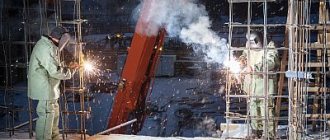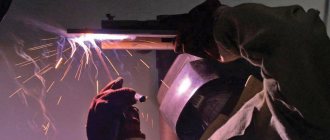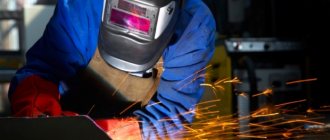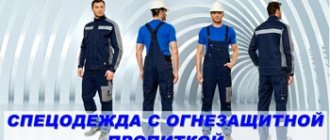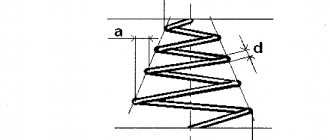Types of suits for welders
Many types of workwear have been developed for welding:
- from suede;
- from tarpaulin;
- with split leather;
- leather;
- from cloth.
Focusing on different climates, there are:
For harsh winters, an insulated suit for welders is produced; it is equipped with a dense, non-flammable lining inside.
Welder's canvas suits or split-split suits are used. Cotton fabric or calico is also used, with cotton insulation inside to maintain warmth.
Summer suits for welders are made from thin fabrics, but with reliable protection. They are used for welding in workshops.
Uniforms are also divided into combined (overalls) and tailored (separate trousers and a jacket below the hips).
Tarpaulin for welding overalls: pros and cons, features
Over the years, canvas suits have been in consistently high demand among welders of various levels and qualifications. This material is produced from natural raw materials: cotton and linen yarn - using plain weave technology, fabric ratio 51% to 49%.
To provide high protection against harmful (thermal radiation, high temperatures) and dangerous (sparks, splashes, scale) effects of welding, the fabric is treated with a special agent that provides fire resistance. Sets made of tarpaulin without impregnation are recommended for use when carrying out short-term, periodic, light and auxiliary work.
The main features of tarpaulin: density and rigidity of the material. In addition, tarpaulin has a whole range of advantages:
- sufficiently reliable protection of the performer;
- ensuring excellent levels of ventilation;
- low cost;
- high strength;
- Care of the robe is easy; dirt should be removed by cleaning;
- the possibility of using tarpaulin sets in any season; winter and insulated models should be lined with fur, wool or other warm material.
The main disadvantages of tarpaulins are the possibility of burns on the fabric as a result of prolonged exposure, the need to independently shake off scale, which can hinder movement.
All types of suits have these disadvantages, regardless of the season of use.
in winter
When considering tarpaulin as a material for winter suit models, the following advantages should be highlighted: the density of the material provides good thermal insulation, which eliminates hypothermia.
In summer
The materials used for sewing summer workwear should have the following advantages: providing excellent ventilation, which guarantees comfort and convenience, as well as an optimal microclimate. Tarpaulin is characterized by all these advantages, which makes this material an excellent option for a summer robe.
Popular suits for welders
- Split leather suits are reliably used to protect metal sparks when burning electrodes (split leather is a substance used in leather processing).
- Welding suits 2.3 - an indicator of numbers - this is 2.3 m of workwear covered with split leather. This is the chest, stomach, arms, this is a reliable apron.
- Suit 2.6 – this version has additional protection at the throat.
Reinforced suit, 1 class. protection
If we take into account the technical characteristics, the product is classified as the first class of protection. This means that it is permissible to work at a distance of two meters from the source of hot metal sparks.
The jacket is fastened with a hidden button closure located in the center of the garment. This design gives comfort when putting on and wearing.
For sewing, canvas fabric with a density of 480 g/m² was used. This is quite enough so that a spark, when it hits the material, does not burn through it. The trousers have a fold-over front with a clasp located at the front.
There are reinforced pads on the knees.
pros
:
- high quality seams;
- budget model;
- comfortable to wear, does not restrict movement;
- the suit is not burned by sparks;
- comfortable fit.
Minuses
:
- not detected.
Mandatory sanitary standards
There is a mandatory GOST for welding suits. There are requirements and mandatory standards for sewing uniforms:
The best quality fabrics with fire-resistant properties are selected, and the uniform should be loose. Fabrics are taken in accordance with European standardization standards: EN 470-1, EN 531, and EN 533.
In the production of fire-resistant fabrics, the following standards must be observed: GOST R 12.4.247-2008 “Special clothing for protection against sparks and splashes of molten metal.”
Suit Hercules 105-0016-01
The model belongs to the first class of protection, warns against industrial contamination and mechanical impacts. The suit consists of 100% cotton, impregnated with fire-resistant impregnation using Proban technology.
The jacket is fastened with buttons and closed with a protective flap on top. Sleeves are adjustable using pat. There are ventilation holes in the back area. The collar is soft and does not rub the neck during long-term use.
The trousers are fastened with internal buttons. The suit has reflective stripes 50 mm wide. They are located in the chest area and at the bottom of the trousers.
pros
:
- stylish, modern design;
- long jacket;
- the presence of reflective stripes;
- average cost per suit;
- ventilation holes to increase comfort.
Minuses
:
- not detected.
Welding suit set
Mandatory as part of a welding suit: a face shield (special glasses) with light filters to protect the eyes.
Even summer workwear is a thick jacket with pants, and closed boots made of genuine leather on the feet. Gloves or leggings with a bell are required so that you can quickly free your hands if necessary. They cover the wrists and are made of beef (pork) leather.
The winter uniform additionally includes overalls under the jacket. Comfortable straps can be adjusted to suit a person's specific height. There is a comfortable elastic band at the waist.
How to make a spot welding machine - how to assemble the machine at home with your own handsHow to assemble a simple welding machine at home: drawings of inverter models and step-by-step assembly instructions
Do-it-yourself welding table - step-by-step instructions for manufacturing and assembly (65 photos)
Leggings for winter have a fur layer inside.
Reference! The gloves come in 5,2,3 finger sizes. Gloves with five fingers are essential for precision work, while gloves with other fingers are essential for the rest.
Closed boots with metal toes and polyurethane soles are required. If work is performed in hazardous conditions, it is better to choose boots with nitrile soles for enhanced protection.
Canvas suit KOS390
The model is made of tarpaulin based on flax and cotton. Material density 550 g/m², lining made of 100% cotton fabric. The insulation is made of batting.
The jacket is fastened with buttons, which are hidden by a canvas lining. The trousers are loose-fitting, without additional reinforced zones. Of the proposed winter models, this suit is one of the cheapest. Let's say when working two meters from the source of hot splashes.
pros
:
- the collar is sewn from cotton fabric, which is why the neck does not rub;
- increased density of the material used;
- inexpensive model;
- Pure cotton lining.
Minuses
:
- The insulation is dense, which can hinder movement during work.
Caring for welding clothing
Any clothing needs care to extend its service life. The welding suit is no exception in this regard.
Here are the basic tips that can be given on caring for this type of clothing:
- Before purchasing, you should carefully read the care information provided on the label. If the label says that the suit can be washed in a washing machine, this is an ideal option - there will be no problems with caring for such a set of clothes;
- All items of clothing should be checked regularly for tears. The slightest defects should be eliminated immediately - you should not wait for the moment when the cut area increases;
- Storage of workwear is recommended in a dry place without exposure to direct sunlight.
Shields and masks
Welding suits protect the body, but how can we protect the eyes from burns and radiation? For this purpose, shields were used for a long time, and then masks made of cardboard and chameleon masks. It is also allowed to wear special glasses.
Recently, shields have already lost their relevance, since in practice they are inconvenient to use. The welder is forced to hold the shield with one hand and do the work with the other. More practical in this regard is a mask made of thick cardboard, equipped with a viewing window with a light filter. Its disadvantage is that first a person must see the place of work, and then lower the mask with a nod of the head or simply with his hand. These few seconds are enough to damage your vision.
The chameleon mask does not need to be lifted before use. Instead of a traditional light filter, it has glass built into it, which acquires a dark color during the ignition of the arc. At the same time, it is possible to customize such a mask for yourself.
How to choose a robe
In order not to make a mistake with your choice, we recommend paying attention to the following features.
Material of manufacture
Welding smocks can be made from a variety of materials. They can also be combined with each other in one suit. For example, the elbow and knee pads may be made of leather, and the rest of the robe is made of cloth.
The stores most often sell robes made of canvas, suede, cloth, leather and split leather. And also their variations. It is better not to consider a canvas suit, since it does not last long and is suitable only for rare welding work.
A suede robe is comfortable to wear, but not always practical. It is difficult to care for and scale must be manually brushed off the fabric.
Leather suits are the most durable and most expensive, but they are also not always comfortable. The skin is quite dense and practically does not stretch, so it is hot and uncomfortable to make sudden movements in such a suit. It is better to buy a robe made of a different material, but with leather inserts.
A suit made of cloth is the lightest and relatively inexpensive. It is convenient to work in, but does not protect well from burns. Plus, it burns well. Even if treated with the composition.
A robe made from split leather is the best option. Split leather is also leather, but not as thick and dense. It is not hot in such a suit and it is quite comfortable to move. But it also costs more than other types.
Climatic conditions
When purchasing, consider the climatic conditions for which the suits are intended. They are conventionally divided into summer and winter. If you need a more versatile option, you can buy a prefabricated robe. They have several items that can be put on or taken off. Depending on the time of year.
Summer clothes for welding are usually light and do not restrict movement. It shouldn't be hot in there. If you work in a heated workshop all year round, you can buy a summer set and wear it all the time.
The winter robe has an insulated lining that provides additional warmth. The lining must also be non-flammable, like the robe itself.
If you want to buy a universal suit for all seasons, it usually consists of overalls and a jacket.
Individual characteristics
Consider your individual characteristics when purchasing a robe. Overalls should be appropriate in size, not restrict movement and not be too loose. The sleeves and legs should be long enough so that you don't have to roll them up.
If you are a woman, try to find women's welding overalls rather than buying men's ones. Because a man's robe will most likely not be comfortable for a standard woman's build. Domestic manufacturers rarely produce suits for women. Therefore, look for a kit from foreign brands or in Chinese online stores.
